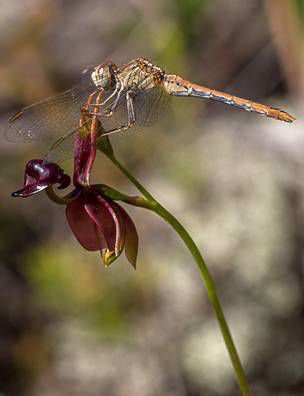On very few occasions, one just has the camera at hand, and therefore manages to capture that special image that presents itself momentarily.
This was indeed the case when Dale Appleton, Parks Vic, was walking with me in the Gherang Gherang Bushland Reserve recently; a dragonfly landed on a Flying Duck Orchid (Caleana major). It circled around in the air, and then landed once again, giving Dale enough time to get this great photo.

The imagination can run wild. Why would a dragonfly be interested in an orchid? We know that dragonflies usually capture their prey in flight – flies, bees, beetles, moths and other flying insects. Sometimes they hover over vegetation and snatch insects perched on plant leaves or stems. They are not interested in eating orchids!
Perhaps this dragonfly was just resting, but it did seem to have a purpose about its actions.
Did it mistake the Flying Duck Orchid for a living creature – a flying insect?
Perhaps it was getting moisture from the tips of the ‘duck’s wings’.
Perhaps some tiny mites were there, which could not be picked up with the camera lens.
No matter what the answer, we have a delightful photograph to share with you.
Flying Duck Orchids are just so special. They belong to a genus of one species which is endemic to Australia. It is no wonder that overseas visitors are almost awestricken when viewing this orchid for the first time. The flowers look like a duck in flight, with its beak held high and wings swept back. They are borne upside down on thin wiry stems. The labellum is the ‘duck’s head’ attached to the column by a curved strap. The lateral sepals are the ‘wings’. The winged column forms ‘the duck’s body’. The petals hang down like legs. The dorsal sepal forms ‘the tail’. The anther, which is part of the column, can be seen, with the pollinia attached, in front of the dorsal sepal.
The orchid is pollinated by a male sawfly. The orchid emits mimic pheromones of a female sawfly to attract the male insect. The hinged labellum snaps shut at the slightest touch, pinning the pollinator against the column, and trapping it there for quite a while, long enough for the pollinia to be glued onto the insect’s thorax, which can then be carried to another flower. Seed capsules, however, are rarely seen.
We are very fortunate that Flying Duck Orchids are widespread in the Anglesea district. They are not common, but grow in reasonable numbers in gravelly and sandy soils in heathlands, open forests and gravel pits. They usually flower from October to December.
This is one of the orchids described, with photographs, in Orchids of the Anglesea District available from Angair.